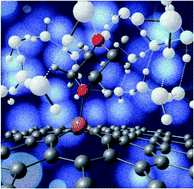Oxidized and Si-doped graphene: emerging adsorbents for removal of dioxane†
Abstract
Graphene-based materials have emerged as new potential adsorbents for the adsorption and removal of persistent pollutants, and they could play a key role in the remediation of 1,4-dioxane. In this framework, a quantum chemistry study was carried out to rationalize the sorption properties of oxidized graphene (GO) and Si-doped graphene (SiG) nanosheets for use in 1,4-dioxane removal, taking into account that these adsorbents are experimentally available. Dispersion corrected PBE-D3/SVP calculations show that GO and SiG adsorbs dioxane through non-covalent and covalent interactions, respectively, with adsorption energies of up to ∼0.9 eV, which represents an important improvement with respect to the adsorption onto intrinsic graphene. The adsorption strength was also rationalized in terms of natural bond orbitals, atoms-in-molecules and energy decomposition analyses. In the case of GO, a high content of hydroxyl and carboxyl functional groups enhances the removal efficiency, and they are responsible for the high adsorption stability in aqueous environments and at room temperature (300 K). In addition, explicit/implicit solvent calculations and molecular dynamics trajectories show that the SiG–dioxane interaction is highly stable at 300 K, without pollutant diffusion; besides, the SiG–dioxane interaction is stabilized in the presence of H2O molecules. All the analyses suggest that GO and SiG should be considered as new remarkable candidates for sorption technologies related to the removal, control and remediation of 1,4-dioxane, where the sorption efficiency is sorted as SiG > GO ≫ G.

- This article is part of the themed collection: 2017 PCCP HOT Articles


 Please wait while we load your content...
Please wait while we load your content...